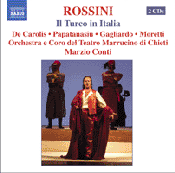Many of these operas have been recorded live. This latest set, Il Turco in Italia, comes from October 2003, and though the back cover of the CD identifies the recording location as the Teatro Marrucino, no audience is heard. However, the aural perspective suggests a live recording, not a studio affair with its more pristine balance.
An understandable misconception places Il Turco as a companion piece, even sequel, to the more popular L’Italiana in Algieri. In truth, the libretto for Turco predates Rossini’s L’Italiana, and the operas share no characters. Turco’s wild, almost modern plot device centers on a poet watching the interactions of the natives of Naples with a Turkish prince, and gathering material for his next play. The romantic complications verge on the chaotic; unsurprisingly, all are resolved for an extended ensemble finale.
Turco may lack an aria or two of a melodic distinction that would make the opera a more frequently performed part of the repertory, but that is not to say that the score is lesser Rossini. It bubbles and percolates with wit, and it has delightfully odd set pieces for variety, such as the act one choral number, “Voga, voga, a terra, a terra.” That piece even features a string accompaniment that resembles the opening of Smetana’s wandering Moldau.
Naxos has a energetic, skillful crew of musicians and singers for its recording. The Teatro Marrucino forces, led by Marzio Conti, may sound a bit thin in the overture, but as support for the singers, they embody all the fun of the score.
Natale de Carolis gets top billing, as Selim, the Turkish prince. His biographical note in the booklet suggests he had a burgeoning career in the late ‘80s, early ‘90s, including a Mozart Figaro at the Metropolitan Opera. His voice retains a charismatic quality, while also showing evidence of wear. Myrto Papatanasiu, whose career began more recently, sings the soprano role of Donna Fiorilla. She doesn’t overplay Fiorilla’s shrewishness, but the opera being a comedy, a touch more color wouldn’t be out of place. Other than that, she uses her appealing voice to fine effect.
In other roles, Amadeo Moretti’s sharp-edged and high-lying tenor makes a good impression singing as Don Narciso (what a tenor character name!), and baritone Massimiliano Gagliardo brings a solid technique to the role of Fiorella’s put-upon spouse.
The booklet has a very brief note on the opera and then a track by track synopsis, along with artists’ notes, all offered only in English. The booklet offers a weblink for an Italian libretto. How much help that will be to non-Italian speaking listeners is questionable.
The Turco recording catalog is not extensive. The Callas recording does not seem to be available at the moment; her admirers will surely be undeterred by that inconvenience. However, the 1998 Decca recording, winner of a Gramophone award, can still be found. Still at full price, the set boasts the leadership of Ricardo Chailly and Cecilia Bartoli’s Fiorella. Miss Bartoli also appears in a recent DVD from Zurich, and she starred in a Covent Garden production last season that earned rave notices.
So perhaps Il Turco in Italia is on the comeback trail. For those who prefer to save a few dollars but who would like to know the opera better, this Naxos set has fortuitously appeared.
Chris Mullins
Los Angeles Unified School District, Secondary Literacy
